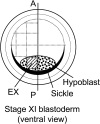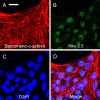Heart myofibrillogenesis occurs in isolated chick posterior blastoderm: a culture model
- PMID: 17327900
- PMCID: PMC1698866
- DOI: 10.1267/ahc.06009
Heart myofibrillogenesis occurs in isolated chick posterior blastoderm: a culture model
Abstract
Early cardiogenesis including myofibrillogenesis is a critical event during development. -Recently we showed that prospective cardiomyocytes reside in the posterior lateral blastoderm in the chick embryo. Here we cultured the posterior region of the chick blastoderm in serum-free medium and observed the process of myofibrillogenesis by immunohistochemistry. After 48 hours, explants expressed sarcomeric proteins (sarcomeric alpha-actinin, 61%; smooth muscle alpha-actin, 95%; Z-line titin, 56%; sarcomeric myosin, 48%); however, they did not yet show a mature striation. After 72 hours, more than 92% of explants expressed I-Z-I proteins, which were incorporated into the striation in 75% of explants or more (sarcomeric alpha-actinin, 75%; smooth muscle alpha-actin, 81%; Z-line titin, 83%). Sarcomeric myosin was -expressed in 63% of explants and incorporated into A-bands in 37%. The percentage incidence of expression or striation of I-Z-I proteins was significantly higher than that of sarcomeric myosin. Results suggested that the nascent I-Z-I components appeared to be generated independently of A-bands in the cultured posterior blastoderm, and that the process of myofibrillogenesis observed in our culture model faithfully reflected that in vivo. Our blastoderm culture model appeared to be useful to investigate the mechanisms regulating the early cardiogenesis.
Figures





Similar articles
-
Significance of bone morphogenetic protein-4 function in the initial myofibrillogenesis of chick cardiogenesis.Dev Biol. 2002 May 15;245(2):291-303. doi: 10.1006/dbio.2002.0637. Dev Biol. 2002. PMID: 11977982
-
Localization of CapZ during myofibrillogenesis in cultured chicken muscle.Cell Motil Cytoskeleton. 1993;25(4):317-35. doi: 10.1002/cm.970250403. Cell Motil Cytoskeleton. 1993. PMID: 8402953
-
Premyofibrils in spreading adult cardiomyocytes in tissue culture: evidence for reexpression of the embryonic program for myofibrillogenesis in adult cells.Cell Motil Cytoskeleton. 1997;37(3):183-98. doi: 10.1002/(SICI)1097-0169(1997)37:3<183::AID-CM1>3.0.CO;2-8. Cell Motil Cytoskeleton. 1997. PMID: 9227849
-
Myofibrillogenesis in skeletal muscle cells.Clin Orthop Relat Res. 2002 Oct;(403 Suppl):S153-62. doi: 10.1097/00003086-200210001-00018. Clin Orthop Relat Res. 2002. PMID: 12394464 Review.
-
Assembly of myofibrils in cardiac muscle cells.Adv Exp Med Biol. 2000;481:89-102; discussion 103-5. doi: 10.1007/978-1-4615-4267-4_6. Adv Exp Med Biol. 2000. PMID: 10987068 Review.
Cited by
-
Histochemical analysis of renal dysplasia with ureteral atresia.Acta Histochem Cytochem. 2009 Jun 27;42(3):65-71. doi: 10.1267/ahc.09009. Epub 2009 Apr 25. Acta Histochem Cytochem. 2009. PMID: 19617953 Free PMC article.
References
-
- Allen E. R., Pepe F. A. Ultrastructure of developing muscle cells in the chick embryo. Am. J. Anat. 1965;116:115–147. - PubMed
-
- Alsan B. H., Schultheiss T. M. Regulation of avian cardiogenesis by Fgf8 signaling. Development. 2002;129:1935–1943. - PubMed
-
- Brand T. Heart development: molecular insight into cardiac specification and early morphogenesis. Dev. Biol. 2003;258:1–19. - PubMed
-
- Callebaut M. Origin, fate, and function of the components of the avian germ disc region and early blastoderm: role of ooplasmic determinants. Dev. Dyn. 2005;233:1194–1216. - PubMed

